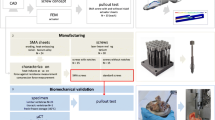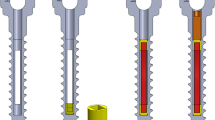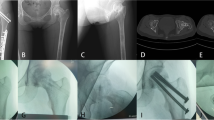Abstract
Introduction
The aim of an intraosseous application of electromagnetic alternating fields is to speed up both the regeneration of osteonecroses and bone regeneration. In clinical studies, the efficiency of the technique could be successfully proven by using a transducer coil. The advantage of the traditional technique was the variety of its applications in connection with various osteosynthesis systems; the disadvantage was a possible failure of the contacting leads and the resulting functional breakdown.
Materials and methods
A newly developed BISS screw (bipolar induction screw system) with integrated coil and electrodes was compared to a standard cannulated screw used in the traditional technique. The strength of BISS screws (n=6) and of cannulated screws (n=6) was evaluated in comparative biomechanical tests. Examinations consisted of torsional and static and dynamic cantilever tests. All screws were made of the same material (TiAl6V4) and had identical outer dimensions.
Results
No significantly lower strengths could be observed when we compared BISS screws with cannulated screws. The BISS screws even showed significantly higher mechanical values due to a reinforcing effect by the attached electrode.
Conclusion
In the modified concept of the new BISS screw, both coil and electrodes are housed in only one cannulated screw. No negative effects concerning mechanical strength and durability were associated with the new screw concept. This provides for a simpler implantation and makes removal easier, while the risk of a cable tear is avoided.







Similar content being viewed by others

References
Ascherl R (1976) Experimentelle Untersuchungen über den elektrischen Widerstand und den Leitwert am lebenden und toten Knochengewebe unter physiologischen Bedingungen sowie nach pathologischen Veränderungen. Thesis, Technische Universität, Munich
Ascherl R, Walz H, Geißdörfer K, Schmeller M-L, Lechner F, Blümel G (1989) Förderung der Knochenheilung durch extrem niederfrequente elektromagnetische Wechselfelder im Experiment. In: Lechner F (ed) Elektrostimulation und Magnetfeldtherapie: Anwendung, Ergebnisse und Qualitätssicherung. Schattauer, Stuttgart, pp 1–9
Berman AT, Reid JS, Yanicko DR Jr, Sih GC, Zimmerman MR (1984) Thermally induced bone necrosis in rabbits. Relation to implant failure in humans. Clin Orthop 186:284–292
Blair B, Koval KJ, Kummer F, Zuckerman JD (1994) Basicervical fractures of the proximal femur: a biomechanical study of 3 internal fixation techniques. Clin Orthop 306:256–263
Bohay DR, Manoli A (1995) Clawtoe deformity following vascularized fibula graft. Foot Ankle Int 16:607–609
Brighton CT, Friedenberg ZB, Black J, Esterhai L, Mitchell JE, Montique F (1981) Electrically induced osteogenesis: relationship between charge, current density and the amount of bone formed. Clin Orthop 161:122–132
Cristofolini L, Viceconti M, Toni A, Giunti A (1996) Influence of thigh muscles on the axial strains in a proximal femur during early stance in gait. J Biomech 28:617–624
Deneka DA, Simonian PT, Stankewich CJ, Eckert D, Chapman JR, Tencer AF (1997) Biomechanical comparison of internal fixation techniques for the treatment of unstable basicervical femoral neck fractures. J Orthop Trauma 11:337–343
Fukada E, Yasuda J (1957) On the piezoelectric effect of bone. J Physiol Soc Jpn 12:1158–1162
Hasegawa Y, Iwata H, Torii S, Iwase T, Kawamoto K, Iwasada S (1997) Vascularized pedicle bone-grafting for nontraumatic avascular necrosis of the femoral head. A 5- to 11-year follow-up. Arch Orthop Trauma Surg 116:251–258
Hernigou P (1999) Treatment of hip necrosis by sequestrectomy and replacement with bone cement. Acta Orthop Belg 65 [Suppl 1]:89–94
Kane SM, Ward WA, Jordan LC, Guilford WB, Hanley EN Jr (1996) Vascularized fibular grafting compared with core decompression in the treatment of femoral head osteonecrosis. Orthopedics 19:869–872
Kraus W (1984) Magnetfeldtherapie und magnetisch induzierte Elektrostimulation in der Orthopädie. Orthopäde 13:78–92
Kraus W, Lechner F (1972) Die Heilung der Pseudarthrosen und Spontanfrakturen durch strukturbildende elektrodynamische Potentiale. Münch Med Wochenschr 114:1814–1819
Loschinger M, Thumm S, Hammerle H, Rodemann HP (1999) Induction of intracellular calcium oscillations in human skin fibroblast populations by sinusoidal extremely low-frequency magnetic fields (20 Hz, 8 mT) is dependent on the differentiation state of the single cell. Radiat Res 151:195–200
Rodemann HP, Bayreuther K, Pfleiderer G (1989) The differentiation of normal and transformed human fibroblasts in vitro is influenced by electromagnetic fields. Exp Cell Res 182:610–621
Rouleau JP, Blasier RB, Tsai E, Goldstein SA (1994) Cannulated hip screws: a study of fixation integrity, cut-out resistance, and high-cycle bending fatigue performance. J Orthop Trauma 8:293–299
Rubin CT, Donahue HJ, Rubin JE, McLeod KJ (1993) Optimization of electric field parameters for the control of bone remodeling: exploitation of an indigenous mechanism for the prevention of osteopenia. J Bone Miner Res 8 [Suppl 2]:573–581
Ryken TC, Clausen JD, Traynelis VC, Goel VK (1995) Biomechanical analysis of bone mineral density, insertion technique, screw torque, and holding strength of anterior cervical plate screws. J Neurosurg 83:325–329
Scully SP, Aaron RK, Urbaniak JR (1998) Survival analysis of hips treated with core decompression or vascularized fibular grafting because of avascular necrosis. J Bone Joint Surg Am 80:1270–1275
Solonen KA, Rindell K, Paavilainen T (1990) Vascularized pedicled bone graft into the femoral head—treatment of aseptic necrosis of the femoral head. Arch Orthop Trauma Surg 109:160–163
Stuermer KM, Schmit-Neuerburg KP (1985) Indications and clinical results of electromagnetically-induced alternating current stimulation of poorly reacting pseudarthroses. Unfallchirurgie 11:197–203
Thumm S, Loschinger M, Glock S, Hammerle H, Rodemann HP (1999) Induction of cAMP-dependent protein kinase A activity in human skin fibroblasts and rat osteoblasts by extremely low-frequency electromagnetic fields. Radiat Environ Biophys 38:195–199
Urbaniak JR, Coogan PG, Gunneson EB, Nunley JA (1995) Treatment of osteonecrosis of the femoral head with free vascularized fibular grafting. A long-term follow-up study of one hundred and three hips. J Bone Joint Surg Am 77:681–694
Vail TP, Urbaniak JR (1996) Donor-site morbidity with use of vascularized autogenous fibular grafts. J Bone Joint Surg Am 78:204–211
Yoon TR, Song EK, Rowe SM, Park CH (2001) Failure after core decompression in osteonecrosis of the femoral head. Int Orthop 24:316–318
Yun YH, Kim NH, Han DY, Kang ES (1993) An investigation of bone necrosis and healing after cryosurgery, phenol cautery or packing with bone cement of defects in the dog femur. Int Orthop 17:176–183
Author information
Authors and Affiliations
Corresponding author
Rights and permissions
About this article
Cite this article
Mittelmeier, W., Lehner, S., Kraus, W. et al. BISS: concept and biomechanical investigations of a new screw system for electromagnetically induced internal osteostimulation. Arch Orthop Trauma Surg 124, 86–91 (2004). https://doi.org/10.1007/s00402-003-0594-9
Received:
Published:
Issue Date:
DOI: https://doi.org/10.1007/s00402-003-0594-9



